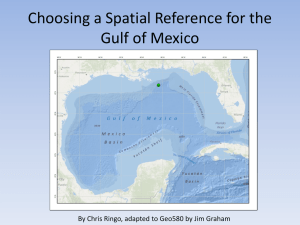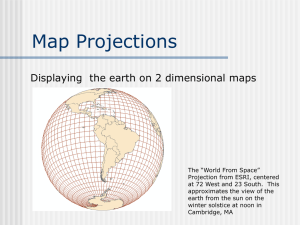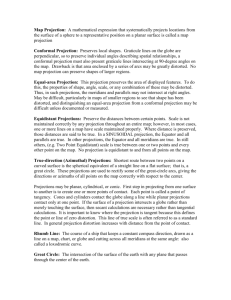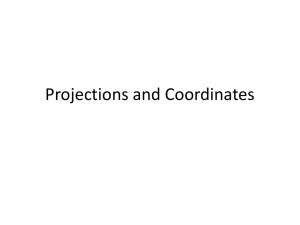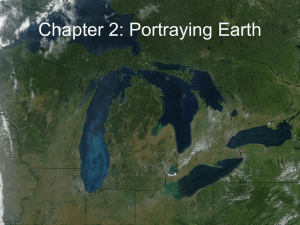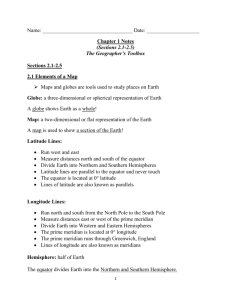UNIT 27 - MAP PROJECTIONS
advertisement
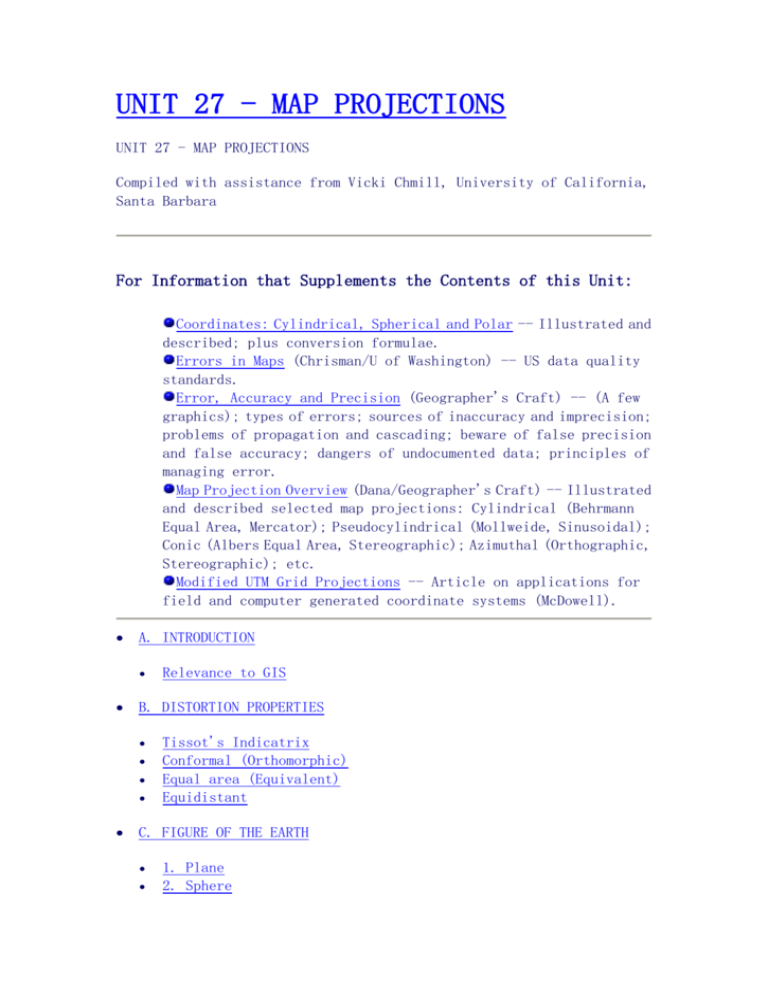
UNIT 27 - MAP PROJECTIONS UNIT 27 - MAP PROJECTIONS Compiled with assistance from Vicki Chmill, University of California, Santa Barbara For Information that Supplements the Contents of this Unit: Coordinates: Cylindrical, Spherical and Polar -- Illustrated and described; plus conversion formulae. Errors in Maps (Chrisman/U of Washington) -- US data quality standards. Error, Accuracy and Precision (Geographer's Craft) -- (A few graphics); types of errors; sources of inaccuracy and imprecision; problems of propagation and cascading; beware of false precision and false accuracy; dangers of undocumented data; principles of managing error. Map Projection Overview (Dana/Geographer's Craft) -- Illustrated and described selected map projections: Cylindrical (Behrmann Equal Area, Mercator); Pseudocylindrical (Mollweide, Sinusoidal); Conic (Albers Equal Area, Stereographic); Azimuthal (Orthographic, Stereographic); etc. Modified UTM Grid Projections -- Article on applications for field and computer generated coordinate systems (McDowell). A. INTRODUCTION Relevance to GIS B. DISTORTION PROPERTIES Tissot's Indicatrix Conformal (Orthomorphic) Equal area (Equivalent) Equidistant C. FIGURE OF THE EARTH 1. Plane 2. Sphere 3. Spheroid or ellipsoid of rotation Accuracy of figures used D. GEOMETRIC ANALOGY Developable surfaces 1. Planar or azimuthal 2. Conic 3. Cylindrical 4. Non-Geometric (Mathematical) projections E. UNIVERSAL TRANSVERSE MERCATOR (UTM) Transverse Mercator Projection Zone System Distortion Coordinates Advantages Disadvantages F. STATE PLANE COORDINATES (SPC) Advantages Disadvantages Use in GIS REFERENCES DISCUSSION AND EXAM QUESTIONS NOTES This unit needs many overhead illustrations. Of course, the best figures are in commercially published books. To avoid copyright infringements, we have not included the masters for overheads needed here. Instead, you are directed to the References which lists several basic texts with good illustrations. We have included suggested overheads giving references and specific page numbers to help you locate suitable figures. UNIT 27 - MAP PROJECTIONS Compiled with assistance from Vicki Chmill, University of California, Santa Barbara A. INTRODUCTION a map projection is a system in which locations on the curved surface of the earth are displayed on a flat sheet or surface according to some set of rules mathematically, projection is a process of transforming global location (j,l) to a planar position (x,y) or (r,q) o for example, the transformations for Mercator projection are: x = l y = loge tan(p/4 + j/2) Relevance to GIS maps are a common source of input data for a GIS o often input maps will be in different projections, requiring transformation of one or all maps to make coordinates compatible o thus, mathematical functions of projections are needed in a GIS often GIS are used for projects of global or regional scales so consideration of the effect of the earth's curvature is necessary monitor screens are analogous to a flat sheet of paper o thus, need to provide transformations from the curved surface to the plane for displaying data B. DISTORTION PROPERTIES angles, areas, directions, shapes and distances become distorted when transformed from a curved surface to a plane all these properties cannot be kept undistorted in a single projection o usually the distortion in one property will be kept to a minimum while other properties become very distorted Tissot's Indicatrix is a convenient way of showing distortion imagine a tiny circle drawn on the surface of the globe on the distorted map the circle will become an ellipse, squashed or stretched by the projection the size and shape of the Indicatrix will vary from one part of the map to another we use the Indicatrix to display the distorting effects of projections Conformal (Orthomorphic) Reference: Mercator projection (Strahler and Strahler 1987, p. 15) a projection is conformal if the angles in the original features are preserved o over small areas the shapes of objects will be preserved o preservation of shape does not hold with large regions (i.e. Greenland in Mercator projection) o a line drawn with constant orientation (e.g. with respect to north) will be straight on a conformal projection, is termed a rhumb line or loxodrome parallels and meridians cross each other at right angles (note: not all projections with this appearance are conformal) the Tissot Indicatrix is a circle everywhere, but its size varies conformal projections cannot have equal area properties, so some areas are enlarged o generally, areas near margins have a larger scale than areas near the center Equal area (Equivalent) Reference: Lambert Equal Area projection (Maling 1973, p. 72) the representation of areas is preserved so that all regions on the projection will be represented in correct relative size equal area maps cannot be conformal, so most earth angles are deformed and shapes are strongly distorted the Indicatrix has the same area everywhere, but is always elliptical, never a circle (except at the standard parallel) Equidistant Reference: Conic Equidistant projection (Maling 1973, p. 151) cannot make a single projection over which all distances are maintained thus, equidistant projections maintain relative distances from one or two points only o i.e., in a conic projection all distances from the center are represented at the same scale C. FIGURE OF THE EARTH a figure of the earth is a geometrical model used to generate projections; a compromise between the desire for mathematical simplicity and the need for accurate approximation of the earth's shape types in common use 1. Plane assume the earth is flat (use no projection) used for maps only intended to depict general relationships or for maps of small areas o at scales larger than 1:10,000 planar representation has little effect on accuracy planar projections are usually assumed when working with air photos 2. Sphere assume the earth is perfectly spherical o does not truly represent the earth's shape 3. Spheroid or ellipsoid of rotation Reference: Ellipsoid of rotation (Maling 1973, p. 2) this is the figure created by rotating an ellipse about its minor axis the spheroid models the fact that the earth's diameter at the equator is greater than the distance between poles, by about 0.3% at global scales, the difference between the sphere and spheroid are small, about equal to the topographic variation on the earth's surface o with a line width of 0.5 mm the earth would have to be drawn with a radius of 15 cm before the two models would deviate o the difference is unlikely to affect mapping of the globe at scales smaller than 1:10,000,000 Accuracy of figures used the spheroid is still an approximation to the actual shape o the earth is actually slightly pear shaped, slightly larger in the southern hemisphere, and has other smaller bulges o therefore, different spheroids are used in different regions, each chosen to fit the observed datum of each region o accurate conversion between latitude and longitude and projected coordinates requires knowledge of the specific figures of the earth that have been used the actual shape of the earth can now be determined quite accurately by observing satellite orbits satellite systems, such as GPS, can determine latitude and longitude at any point on the earth's surface to accuracies of fractions of a second o thus, it is now possible to observe otherwise unapparent errors introduced by the use of an approximate figure for map projections D. GEOMETRIC ANALOGY Developable surfaces the most common methods of projection can be conceptually described by imagining the developable surface, which is a surface that can be made flat by cutting it along certain lines and unfolding or unrolling it Reference: Developable surfaces (Maling 1973, pp. 55-57) the points or lines where a developable surface touches the globe in projecting from the globe are called standard points and lines, or points and lines of zero distortion. At these points and lines, the scale is constant and equal to that of the globe, no linear distortion is present if the developable surface touches the globe, the projection is called tangent if the surface cuts into the globe, it is called secant o where the surface and the globe intersect, there is no distortion o where the surface is outside the globe, objects appear bigger than in reality - scales are greater than 1 o where the surface is inside the globe, objects appear smaller than in reality and scales are less than 1 Reference: Projection equations (Maling 1973, pp. x-xi and 234-245) note: symbols used in the following: l - longitude j - latitude c - colatitude (90 - lat) h - distortion introduced along lines of longitude k - distortion introduced along lines of latitude (h and k are the lengths of the minor and major axes of the Indicatrix) commonly used developable surfaces are: 1. Planar or azimuthal a flat sheet is placed in contact with a globe, and points are projected from the globe to the sheet mathematically, the projection is easily expressed as mappings from latitude and longitude to polar coordinates with the origin located at the point of contact with the paper o formulas for stereographic projection (conformal) are: r = 2 tan(c / 2) q = l h = k = sec2(c / 2) References: Azimuthal projections (Strahler and Strahler 1987, p. 13, Robinson et al 1984, p. 102) o stereographic projection o gnomic projection o Lambert's azimuthal equal-area projection o orthographic projection 2. Conic the transformation is made to the surface of a cone tangent at a small circle (tangent case) or intersecting at two small circles (secant case) on a globe mathematically, this projection is also expressed as mappings from latitude and longitude to polar coordinates, but with the origin located at the apex of the cone o formulas for equidistant conical projection with one standard parallel (j0 , colatitude c0) are: r = tan(c0) + tan(c - c0) q = n l n = cos(c0) h = 1.0 k = n r / sin(c) Examples o References: Conic projections (Strahler and Strahler 1987 p. 14, Maling 1973, p. 164) o o o Alber's conical equal area projection with two standard parallels Lambert conformal conic projection with two standard parallels equidistant conic projection with one standard parallel 3. Cylindrical developed by transforming the spherical surface to a tangent or secant cylinder mathematically, a cylinder wrapped around the equator is expressed with x equal to longitude, and the y coordinates some function of latitude o formulas for cylindrical equal area projection are: x = l y = sin(j) k = sec(j) h = cos(j) Examples o References: Mercator and Lambert projections (Strahler and Strahler 1987, p. 15, Maling 1973, p. 72) o note: Mercator Projection characteristics meridians and parallels intersect at right angles straight lines are lines of constant bearing projection is useful for navigation great circles appear as curves 4. Non-Geometric (Mathematical) projections some projections cannot be expressed geometrically o have only mathematical descriptions Examples o o o Reference: Non-geometric projections (Robinson et al, 1984, p. 97) Molleweide Eckert E. UNIVERSAL TRANSVERSE MERCATOR (UTM) UTM is the first of two projection based coordinate systems to be examined in this unit UTM provides georeferencing at high levels of precision for the entire globe established in 1936 by the International Union of Geodesy and Geophysics o adopted by the US Army in 1947 o adopted by many national and international mapping agencies, including NATO is commonly used in topographic and thematic mapping, for referencing satellite imagery and as a basis for widely distributed spatial databases Transverse Mercator Projection results from wrapping the cylinder around the poles rather than around the equator the central meridian is the meridian where the cylinder touches the sphere o theoretically, the central meridian is the line of zero distortion o by rotating the cylinder around the poles o the central meridian (and area of least distortion) can be moved around the earth for North American data, the projection uses a spheroid of approximate dimensions: o 6378 km in the equatorial plane o 6356 km in the polar plane Zone System Reference: UTM zones (Strahler and Strahler 1987, p. 18) in order to reduce distortion the globe is divided into 60 zones, 6 degrees of longitude wide o zones are numbered eastward, 1 to 60, beginning at 180 degrees (W long) the system is only used from 84 degrees N to 80 degrees south as distortion at the poles is too great with this projection o at the poles, a Universal Polar Stereographic projection (UPS) is used each zone is divided further into strips of 8 degrees latitude o beginning at 80 degrees S, are assigned letters C through X, O and I are omitted Distortion to reduce the distortion across the area covered by each zone, scale along the central meridian is reduced to 0.9996 o this produces two parallel lines of zero distortion approximately 180 km away from the central meridian o scale at the zone boundary is approximately 1.0003 at US latitudes Coordinates coordinates are expressed in meters o eastings (x) are displacements eastward o northings (y) express displacement northward the central meridian is given an easting of 500,000 m the northing for the equator varies depending on hemisphere o when calculating coordinates for locations in the northern hemisphere, the equator has a northing of 0 m o in the southern hemisphere, the equator has a northing of 10,000,000 m Reference: UTM coordinates (Strahler and Strahler 1987, p. 19) Advantages UTM is frequently used consistent for the globe is a universal approach to accurate georeferencing Disadvantages full georeference requires the zone number, easting and northing (unless the area of the data base falls completely within a zone) rectangular grid superimposed on zones defined by meridians causes axes on adjacent zones to be skewed with respect to each other o problems arise in working across zone boundaries o no simple mathematical relationship exists between coordinates of one zone and an adjacent zone F. STATE PLANE COORDINATES (SPC) SPCs are individual coordinate systems adopted by U.S. state agencies each state's shape determines which projection is chosen to represent that state e.g. a state extended N/S may use a Transverse Mercator projection while a state extended E/W may use a Lambert Conformal Conic projection (both of these are conformal) projections are chosen to minimize distortion over the state o a state may have 2 or more overlapping zones, each with its own projection system and grid units are generally in feet o Advantages SPC may give a better representation than the UTM system for a state's area SPC coordinates may be simpler than those of UTM Disadvantages SPC are not universal from state to state problems may arise at the boundaries of projections Use in GIS many GIS have catalogues of SPC projections listed by state which can be used to choose the appropriate projection for a given state REFERENCES Maling, D.H., 1973. Coordinate Systems and Map Projections, George Phillip and Son Limited, London. Robinson, A.H., R.D. Sale, J.L. Morrison and P.C. Muehrcke, 1984, Elements of Cartography, 5th edition, John Wiley and Sons, New York. See pages 56-105. Snyder, J.P., 1987. Map Projections - A Working Manual, US Geological Survey Professional Paper 1395, US Government Printing Office, Washington. Strahler, A.N. and A.H. Strahler, 1987. Modern Physical Geography, 3rd edition, Wiley, New York. See pages 3-8 for a description of latitude and longitude and various appendices for information on coordinate systems. DISCUSSION AND EXAM QUESTIONS 1. Define the three standard properties of map projections: equal-area, equidistant and conformal. Discuss the relative importance of each for different applications. What types of applications require which properties? 2. What type of projection would you expect to be used in the following circumstances, and why? a. an airline pilot flying the North Atlantic between New York and London. b. a submarine navigating under the ice of the North Pole. c. an agricultural scientist assembling crop yield data for Africa. d. an engineer planning the locations of radio transmitters across the continental US. 3. What map projections would you choose in designing a workstation to be used by scientists studying various aspects of global environmental change? 4. By examining the list of SPC systems adopted by the states, what can you deduce about the criteria used to determine the projection adopted and the number of zones used? You will need a map of the US showing the boundaries of states. Are there any surprising choices?
